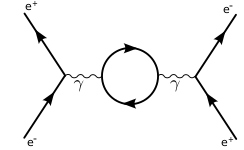Although the laws of physics are now very well known, in most real-life situations the associated mathematical problem is far too complex to be solved. In some cases, however, some particularly simple physics emerge from this complexity. A famous example is that of "
cuprate" materials which, for reasons still poorly understood, become superconducting at abnormally high temperatures (up to 160K). Understanding the emergence of these new phenomena from the dynamics of the elementary constituents of matter (here electrons) is a central problem of theoretical physics known as the quantum manybody problem.
In recent years, physicists have also become interested in the
out-of-equilibrium manybody problem. The concept of "quantum computer" is a form of artificial out-of-equilibrium quantum manybody problem: one builds a correlated system from which one expect the emergence of well defined mathematical properties that would allow one to perform certain calculations.
In its standard formulation (in "
Feynman diagrams"), the quantum manybody problem is being addressed order by order. The zero order corresponds to a free dynamic where each particle evolves independently of its neighbors. Order 1 corresponds to the "average field" where each particle feels a force field corresponding to the average of its neighbors. Order n includes processes where correlations appear between n different particles. The technical difficulty stems from the very rapid proliferation of the number of associated contributions: the calculation at order n corresponds to n! integrals in n dimensions (recall 10! = 3.6 million, 20! = 2.4 billions of billions). Traditionally, this kind of calculation is done by hand, and rarely beyond order 1 or 2.
An IRIG team has recently made an important step forward by developing an algorithm that allows this type of calculation to be performed on the computer with a computational complexity that scales much more favorably: it grows in 2
n much slower than n! (2
10= thousand, 2
20= 1 million). Researchers have made calculations up to order 15, far beyond what was possible until now. This new calculation technique has already made it possible to understand the dynamics of a spin quantum bit when it interacts with neighboring electrodes and is kept in a non-equilibrium situation. The non-equilibrium
Kondo problem has thus received its first exact numerical solution.
A
cuprate is a ceramic with totally unusual magnetic and superconducting properties.
Thermodynamic equilibrium is the state towards which any isolated system reaches relaxes after a sufficiently long time.

In theoretical physics, a
Feynman diagram is a graphical representation of particular mathematical equations describing the interactions of quantum particles within the framework of quantum field theory.
The
Kondo effect is a model quantum many body problem where electronic repulsion gives rise to a magnetic interaction that eventually leads to an attractive interaction. It is well understood at thermodynamic equilibrium but its non-equilibrium study is much more delicate.